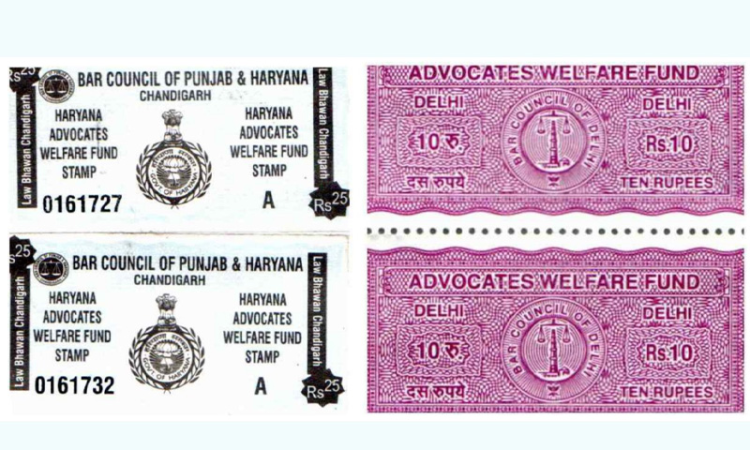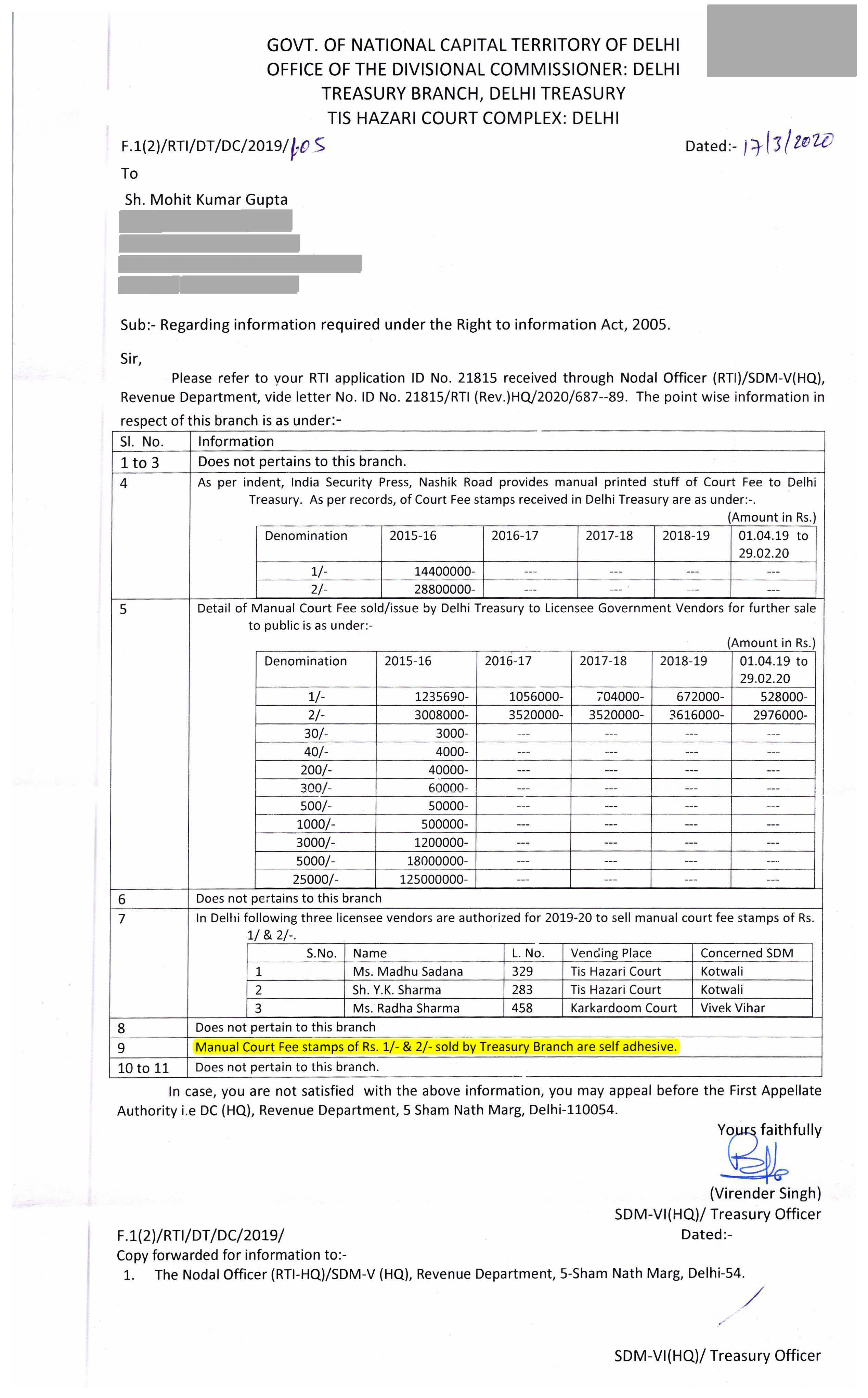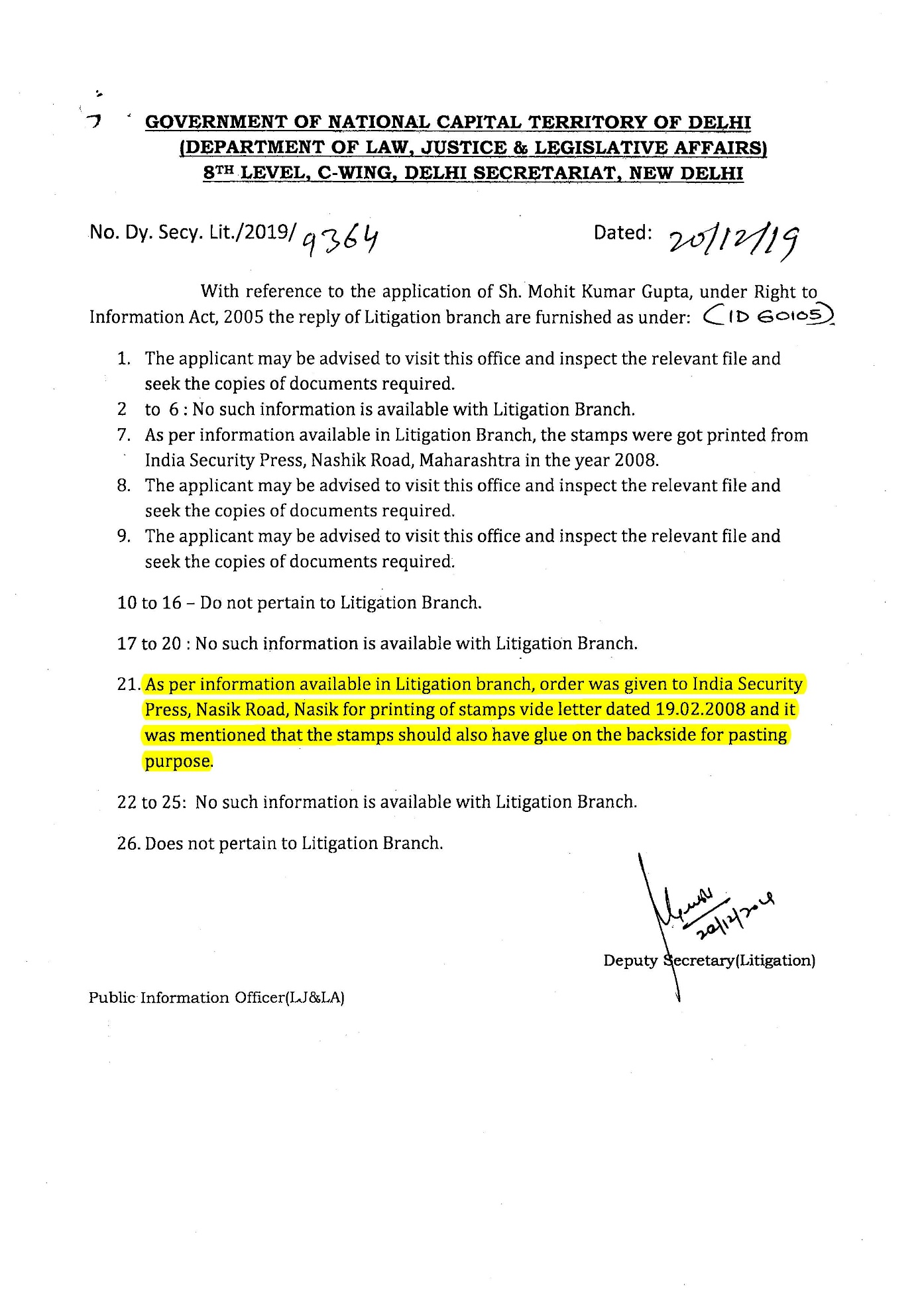Advocates' Welfare Fund – Is There A Need To Have A True Self-Adhesive (Self-Sticking) Stamp In Delhi?
Mohit Kumar Gupta
23 Oct 2021 11:31 AM IST

Disclaimer: The cover image has been prepared using scanned images of the original Advocates' Welfare Fund stamps.
"He who has health has hope; he who has hope has everything"- Arabian proverb.
The Delhi's culture of litigation has one thing common for the learned advocates to have experienced regularly, and yes, for the others too, including the court clerks, and that is the Advocates' Welfare Fund stamp, which is being pasted on the Vakalatnama for its admissibility in the court of law. Traditionally and in fact now also, without any substantial exceptions but with few aberrations, and during ever usual urgency in filing matters, such stamp, and also court stamps, are being pasted using saliva on the back of the stamps to realize its self-adhesive ability. The practice has gained a wide social acceptance in the litigation circle, and the same is practiced as a matter of learning being passed on from generation to generation.
Before we advert out attention to the issue in its right perspective, the force as well as the source of the underlying law vis-à-vis the need to paste the Advocates' Welfare Stamp be understood from a bare perusal of the relevant texts, the same being reproduced herein below:
ADVOCATES WELFARE FUND ACT, 2001
Section 2(n): 'stamp' means the Advocates Welfare Fund Stamp printed and distributed under Section 26.
CHAPTER VI PRINTING, DISTRIBUTION AND CANCELLATION OF STAMPS
Section 26: Printing and distribution of Advocates Welfare Fund Stamps by State Bar Council.
- The appropriate Government shall, on a request made by the State Bar Council in this behalf, cause to be printed and distributed Advocates Welfare Fund Stamps of the value of five rupees or such other value, which may be prescribed, inscribing therein Advocates Welfare Fund Stamp, in such design as may be prescribed.
- Every stamp referred to in sub-section (1) shall be of the size 2.54 c.m. by 5.08 c.m. and sold to the advocates.
- The custody of the stamps shall be with the State Bar Council.
- The State Bar Council shall control the distribution and sale of the stamps through the State Bar Associations and the State Advocates Associations.
- The State Bar Council, the State Bar Associations and the State Advocates Associations shall keep proper accounts of the stamps in such form and manner as may be prescribed.
- The State Bar Associations and State Advocates Associations shall purchase the stamps from the State Bar Council after paying the value thereof as reduced by ten per cent of such value towards incidental expenses.
Section 27: Vakalatnama to bear stamps.
- Every advocate shall affix stamp of a value of -
(a) five rupees on every Vakalatnama filed by him in a District Court or a court subordinate to the District Court;
(b) ten rupees on every Vakalatnama filed by him in a tribunal or other authority or a High Court or the Supreme Court: Provided that the appropriate Government may prescribe the value of the stamps not exceeding twenty-five rupees to be affixed under this sub-section: Provided further that the appropriate Government may prescribe different value of the stamps to be affixed on every Vakalatnama to be filed in a District Court, or a court subordinate to the District Court or a tribunal or other authority or a High Court or the Supreme Court.
- the value of the stamp shall neither be the cost in a case nor be collected in any event from the client.
- Any contravention of the provisions of sub-section (1) or sub-section (2) by any advocate shall disentitle him either in whole or in part to the benefits of the Fund and the Trustee Committee shall report such contravention to the State Bar Council for appropriate action.
- Every stamp affixed on every Vakalatnama filed before a District Court or a court subordinate to the District Court or a tribunal or other authority or a High Court or the Supreme Court shall be cancelled in such manner as may be prescribed.
DELHI ADVOCATES' WELFARE FUND RULES, 2001
Section 21: Value and Design of Stamps.
(1) Stamps shall be printed in the denominations of five rupees and ten rupees.
(2) Every stamp shall have the emblem of the Bar Council of Delhi with the inscription of the words "The Bar Council of Delhi" along with the words "Advocates' Welfare Fund Stamp" as well as its value in terms of rupees.
Section 22: Accounts of Stamps.
(1) The Bar Council of Delhi, the Bar Associations and the Advocates' Associations recognized by the Bar Council under section 16 shall keep accounts of the stamps in Form — IX and shall also maintain the following:
(i) Register showing the stock of stamps;
(ii) Register of sale/purchase of stamps;
(iii) Register showing printing/distribution of stamps;
(iv) Day Book;
(v) Ledger;
(vi) Cash Book;
(vii) Receipt Book with inner foil;
(viii) Voucher file;
(ix) Other registers, files and records as may be required.
(2) Registers, etc., shall be maintained in proper format.
Section 23: Cancellation of Stamps.
(1) No vakalatnama requiring a stamp under the Act shall be filed or acted upon in any proceeding in any court, tribunal or other authority until the stamp has been cancelled.
(2) Such officers as the court, tribunal or other authority may, from time to time, appoint shall, on receiving any such vakalatnama, forthwith effect such cancellation by punching out the figure and the part removed by punching shall be burnt or mutilated or otherwise destroyed.
Delhi Advocates' Welfare Fund (Amendment) Rules, 2019
Amendment of Rule 21: In the Delhi Advocates' Welfare Fund Rules, 2001 -
- Rule 21 shall be re-numbered as Rule 21 A and before that rule as so re-numbered, the following rule shall be inserted, namely:-
"21. Vakalatnama to bear stamps. - Every advocate shall affix a stamp of a value of twenty-five rupees on every Vakalatnama to be filed by him in the courts namely Supreme Court, High Court, District Court or a court subordinate to the District Court, tribunals and other authorities, wherever Vakalatnama is filed."
- In Rule 21 A as so re-numbered, for sub-rule (1), the following shall be substituted, namely:-
"21A. Value and Design of Stamps.
(1) Stamps shall be printed in the denominations of twenty-five rupees."
COURT-FEES AND STAMPS (DELHI HIGH COURT WEBSITE)
Part B: I. Kinds of stamps - Section 6 provides that the stamps to be used under the Act shall be impressed or adhesive.
THE DELHI COURT-FEE STAMP RULES, 1954
1. Number and kind of stamps to be used when fees amount to less than Rs. 25 - When in any case the fee chargeable under the Act is less than Rs. 25 and the amount can be denoted by a single adhesive stamp such fee shall be denoted by a single adhesive stamp of the required value bearing the words "Court-fee" and over printed with the word "Delhi". But, if the amount cannot be denoted by a single adhesive stamp, or if a single adhesive stamp of the required value is not available, a stamp of the next lower value available shall be used and the deficiency shall be made up by the use of one or more additional adhesive stamps of the next lower value which may be required to make up the exact amount of the fee.
The above law, in force as on date, clearly provides that a stamp i.e. Advocates Welfare Fund Stamp, of a value of twenty-five rupees on every Vakalatnama shall be affixed when such vakalatnama is filed in the courts namely Supreme Court, High Court, District Court or a court subordinate to the District Court, tribunals and other authorities. Although Section 6 of the Advocates Welfare Fund Act, 2001 provides that the stamps to be used under the Act shall be impressed or adhesive, the State is continuing with the adhesive stamps only, for such purposes. It is interesting to also note, as provided on https://philatino.com/pages/fa/stampinfo.html, that one of the earliest uses of adhesive stamps to pay tax was the Court Fee system, set up in the Indian feudal states as early as 1797, almost 50 years before the first postal stamps. But, what is actually meant by the terms viz. 'adhesive' or 'self-adhesive' in the practical sense?
The Oxford Dictionary defines the term 'Self-adhesive' as "covered on one side with a sticky substance so that it can be stuck to something without the use of glue, etc.". On the judicial side, the Customs, Excise and Gold Tribunal, Delhi in the matter of Kay Pee Enterprises vs Collector of Customs, 1991 (32) ECC 173 as decided on 30 November, 1988 has too touched upon its meaning in the following terms:
"Secondly, the words used are "Adhesive tapes" and the word "tape" in the normal parlance means "narrow cotton or linen strip used for tying up parcels and in dress-making, etc." but this is qualified by the word "adhesive" which means having the property of adhering or sticking." (emphasis supplied). But the clarity does not seem forthcoming. If the above meaning is attempted to be understood in its utility/nature/property of adhering or sticking, then the question erupts as to why saliva primarily or water in sponge pad alternatively, is used and why the stamp is still regarded natural or self-adhesive? It is learnt that the gum used on the back side of the stamp is composed of polyvinyl alcohol and dextrin and are water soluble elements. The dextrin is derived from starch (e.g. potato) and the vinyl alcohol is a synthetic derived from petroleum; and a single standard postage stamp contains 5.9 calories and Special or Commemorative stamps 14.5 calories, which might be found same or similar for the Advocates' Welfare Fund stamp too. To avoid offending any religious group(s) or vegetarians, no animal products are involved in such stamps these days. Further, other materials like Gum Arabic or Acacia Gum as derived from the acacia plant, glue, gelatin, could well be used to provide adhesiveness to the stamps. If one has to really use saliva or water in sponge pad to achieve the sticking nature of the stamp, then in no sense, such stamp could be regarding as self-adhesive, however, the State has a different understanding and answer to the same. An application under Right to Information Act, 2005 was filed with Department of Law, Justice & Legislative Affairs, Government of NCT of Delhi on 16 December, 2019 seeking, inter alia, as to whether "Advocates Welfare Stamps are self‐adhesive or normal without glue", to which it has been responded vide reply dated 20 December, 2019 that "As per information available in Litigation branch, order was given to India Security Press, Nasik Road, Nasik for printing of stamps vide letter dated 19.02.2008 and it was mentioned that the stamps should also have glue on the backside for pasting purpose." Whereas, replying to an another RTI Application dated 23 January, 2020 seeking information, inter alia, as to whether "Court Fees are self-adhesive or normal without glue", the SDM-VI(HQ)/ Treasury Officer from the Treasury Branch, Office of Divisional Commissioner, Delhi informed vide letter dated 17.03.2020, that "Manual Court Fee stamps of Rs. 1/- & 2/-sold by Treasury Branch are self adhesive". From the abovementioned replies, it can be safely inferred that the State believes, in a mixed approach, that glue on the back side of the stamp, makes it self-adhesive since it can be so used for pasting purposes, albeit in actual, the adhesive effect is achieved through the consequent and required use of water or water based material like saliva.


Whether the said understanding and its materialistic form, be anyway regarded as expedient for the system and its stakeholders? The answer should be 'No', particularly in light of the noted advancement in technology in the contemporary times. The present practice of using saliva to paste the stamps on paper is not only unattractive but also unhealthy. Many researchers on the same have shown that the associated possible risk of infection with this practice is quite high. According to, 'The transmission of bacteria and viruses on gummed paper' By S. SELWYN Bacteriology Department, University of Edinburgh, it has come to light that "Although pathogenic bacteria and viruses were not isolated from sample envelopes obtained from various sources, the gums used in manufacture were found to exert a protective effect against death from desiccation on the bacteria and viruses which had been introduced into them". The study further attributes these self-gummed surfaces to result in the longer survival of bacteria. It has been observed that certain gums provide favourable conditions for the longer survival of the bacteria and viruses and can extend up to 4 years. The material present in gum evidently contain all the nutrients necessary for the growth of widely differing bacteria. According to another research, it is found that at room temperature, survival of bacteria in acid gum is not greatly inferior to survival in a can of meat. In fact, on May 18th, 2020, the Tis Hazari Courts issued a circular asking the lawyer, munshis, litigants, naib courts, and police officials to not use saliva while affixing the court fee stamp in order to prevent the spread of COVID-19 infection. Also in 1875, in the Parliamentary Debates of the House of Representatives (New Zealand), a provision to enable the public to use self-adhesive stamps was added in the bill. It seems that we are still living in the 18th century and not aware of modern advancements. The self-adhesive stamps on the contrary are easier and convenient to use. The actual self-adhesive stamp is comprised of a layer of paper bearing a printed stamp design on its front and having perforated edges, a layer of pressure-sensitive adhesive on the back of the stamp paper, and a peel able backing sheet covering the adhesive, wherein the pressure-sensitive adhesive layer is patterned such that there is little, or no adhesive adjacent to the perforated edges of the paper. The relatively new form of self-adhesive stamps which are also called pressure-sensitive stamps has a smooth waxed or polymer-coated release carrier backing which can be stuck on to paper with zero contact to the orifices of the body. This glue is safe to use with bare hands and does not give off smells or dangerous fumes. The associated health risks are far less. This can be easily brought into use and will be efficient and in tune with the current advancements. The producers and distributors can remain the same, which implies no down sides.
The co-relation of the current practice with entailing consequences on 'Health' is clearly discernible and therefore the role of the State cannot be overemphasized. The Article 21 of the Constitution of India guarantees a fundamental right to life & personal liberty to every person. The Article in its wider meaning includes the right to livelihood, better standard of life, a hygienic condition in workplace & leisure. Article 21 should be read with Articles 38, 42, 43, and 47 to understand the nature of the obligation of the state in order to ensure the effective realization of this right. The State under Part IV, the Directives Principles of State Policy, has the obligation to look after the health of the citizens. In the matter of Vincent Parikurlangara vs. Union of India (1987) 2 SCC 165, the Hon'ble Supreme Court of India, on the right to health care, had observed that (relevant extracts only), "The right of maintenance and improvement of public health is included in the right to life with human dignity enshrined in Article 21. A healthy body is the very foundation of all human activities. Maintenance and improvement of public health have to rank high as these are indispensable to the very physical existence of the community and on the betterment of these depends the building of the society of which the Constitution makers envisaged. Attending to public health in our opinion, therefore is of high priority-perhaps the one at the top". Further, in the matter of State of Punjab v. Mohinder Singh Chawla (1997) 2 SCC 83, the Hon'ble Court too held that (relevant extract only), "the right to health is integral to right to life". Apart from recognizing the fundamental right to health as an integral part of the Right to Life, there is sufficient number of case laws, not only from the Hon'ble Supreme Court from the various Hon'ble High Courts in the country, that lays down that 'Right to Health' should be the top priority of the state.
We all understand that good health is a pre-condition for a good life. If the stamps being made to use with saliva are allowed to be so continued for more, the health of the people, especially learned advocates and other stakeholders in the system, will deteriorate and this will impinge upon their right to life. Hence, the printing of such stamps (using saliva on the back side of the stamp and then pasting it on the paper) should be banned and true self-adhesive stamps, in the nature of self-sticking stamps, which can be pasted by peeling off the back-sheet/sticker) should be used invariably at all levels, in the official transactions of justice delivery system. Well, the right step has been found to have been so taken by the Bar Council of Punjab and Haryana (and others, if there are any), when it launched the self-sticking Advocates' Welfare Fund Stamp for the states of Punjab and Haryana, which is totally different from the one being available in Delhi. Thus, the new measures need to be brought into effect by the State at the earliest convenient, to effectuate the welfare of the learned advocates accordingly.

The author, Mohit Kumar Gupta is an advocate at High Court of Delhi and District Courts-Delhi NCR. He can be reached at contact@blackrobeslegal.com for any questions or feedback concerning the write-up. The views expressed herein are personal in nature which do not constitute legal advice as such and is not intended to be understood as solicitation of work.


